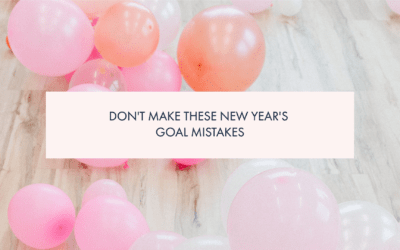Do you find it hard to stick to the goals you set for yourself? Do you start with the best intentions but by the end of the year you can’t really remember what they were, and you probably haven’t achieved them?
If so, you’re definitely not alone.
Setting goals seems so simple. Just decide what you’re going to do and then do it.
But if you’ve ever tried to do something you don’t enjoy, you’re scared of, or just find challenging, you know that it’s not as simple as that.
In fact, although deciding on what your goal is going to be does take some practice, it’s actually the easy part. Persisting with the goal in the face of interruptions and doubts and discomfort is the hard part.
We love dreaming about the future and thinking about how amazing our lives could be with our business running smoothly and paying us a fair wage.
Doing the work to make it happen? We definitely don’t like that as much, because it’s long and boring and we’re always worried about whether it’s working or not, or whether it’s the right thing for us to be doing.
Plus, we’ve probably got plenty of people willing to interrupt us for reasons that may or may not be emergencies and, let’s face it, they’re usually not.
And of course there’s the siren song of everything that distracts us from our work – doomscrolling, Netflix, TikTok, the building work outside, the mess – all of which become even more distracting when we’re unsure about the work we’re doing.
So with all of this going against you, how do you actually ever get the work done? Is it just out of our control and we just have to accept that if we reach our goals it’s going to be really painful?
Yes.
And no, of course.
We can’t control everything and we shouldn’t try. And, although it shouldn’t be painful, it’s always going to be uncomfortable to do something that challenges us.
What we should aim for is to build a support system that helps us to persist with our goals, even though things are sometimes chaotic and out of our control.
And the good news is that once you build a system like that, you can use it with every goal going forwards, so that you actually become better and better at getting the work done.
So what would it look like? Here are my top 3 suggestions to make it more likely that you persist with your goals, even in the midst of distractions and interruptions.
Remind yourself of why it matters
I think that one of the reasons the work becomes so easy to put off, is because we forget why we’re doing it. And we forget what we’re giving up when we choose something else.
Every week in Makers’ Momentum Club, I ask members to share their single most important goal for the week. And at the end of the week, I check in with them and see how they got on with it.
Quite often, members can’t remember what they posted on Monday or they got busy with other things and didn’t do the thing they posted.
These both seem completely reasonable and normal, until you think about the fact that on Monday this was the single most important thing that you needed to do this week, and by Friday you not only haven’t worked on it, but you can’t remember what it was.
This shows that we can’t rely on just always knowing what the most important thing is. We can’t trust that we’re always going to work on it just because it’s important.
We get busy. We get interrupted. We get tired. And we forget. We forget not only what it was, but why it matters.
As we get more and more into the actual nitty gritty of the work that needs to be done, we get further and further away from that dream or that goal that we set at the beginning and we need a way to regularly remind ourselves.
So you need a system for regularly highlighting not only your goal, but why it’s important and what you’re going to feel like when it’s achieved (or maybe even what you’re going to feel like if it’s not achieved)
Emotions are a much stronger reminder and motivator than anything else so tying your goal to how you want to feel can be really powerful.
Let’s look at an example so that you can see one way that this could work in practice.
Write down your goal on a piece of paper, along with why you need to get this done and what your life or business will be like once it’s completed.
At the beginning of each work day, whenever you sit down to work and it’s that moment where you have to decide what you’re going to do, I want you to take that piece of paper and read it.
Then set a timer for 5 minutes, close your eyes and try to imagine what it’s going to feel like when this is done. Think about what it’s going to mean for you and your business. How is your life or business going to be different?
Depending on the goal, you might imagine the obstacles that are going to be removed or the opportunities that will be in front of you. You might imagine what your days will be like, or what your working week will be like.
Reconnecting the work to the outcome you want to achieve, or the thing you want to avoid, can be really motivating and remind you why this needs to come before some of the other stuff.
And a visualisation like this is only one way to achieve it. You could also use a vision board, or make a short video clip of you telling yourself why this matters. You could follow a guided meditation or visualisation using the particular goal each day. Or you could write about why this matters for 5 minutes or so each morning.
The key is that you set aside time, every day, to remind yourself of what is most important and then you directly connect that to the work so that it’s no longer a boring or uncomfortable slog. It’s a direct route to getting what you want most.
Set a timeline
One of the reasons why our annual goals are difficult to achieve is because they’re big. They have to be.
When you’re thinking about where you want to be one year from now, most people aren’t thinking about a small thing that they could achieve next week.
We want bigger changes than that and so our goals for the year are big things. Maybe we want to increase our audience by several hundred, or even a thousand. Maybe we want to double our sales.
These aren’t the kinds of things you can do in a short space of time. If we’re serious about getting them done, they require sustained work over a period of days, weeks and months.
And they also probably require us to try a few different things.
For example, if you’re trying to grow your audience, you might need to:
— create a lead magnet
— engage regularly on social media
— learn about advertising and create your first ad
— try to get some press or influencer coverage
And any one of these tasks could take you down a rabbit hole and distract you away from getting the others done.
Maybe you start engaging regularly on social media but then you start wondering about whether you should do more Reels and maybe you need a new camera and some lighting and you’ll have to learn how to edit video.
And suddenly, you haven’t done any of the rest of your audience growth plan.
When we don’t decide what we’re going to do in any given timeframe, something else will appear and fill the time. And even if that is something that ultimately helps your business, it’s not following the plan you had for how to grow your audience as quickly as possible.
So you need to set a timeline for when each of these pieces of work is going to get done.
This is when a lot of us get uncomfortable, because committing to a timeline means we have to actually make plans to do the work and what if things come up and we’re not able to get it done?
But that’s actually what we want.
We want to try and see how much we can get done with all of the interruptions and the distractions that we have in our everyday lives, because it allows us to understand how much we can and cannot do in a certain period of time.
Once we understand how much time we have available to work on this goal and what else is getting in the way, we can start to adjust the work we’re setting ourselves to make it more reasonable, and we may also be able to work on reducing some of the distractions.
If we just keep setting goals we’re never going to be able to achieve, not measuring them and never starting the work, then of course we’re going to feel frustrated and disappointed.
So let’s look at an example.
The Maker’s Yearbook asks you to set no more than 5 annual goals, but of course you could set fewer than that, or even just one.
Let’s say you choose to set one annual goal and that is is to increase your Christmas sales by 30%. We need to work out how we’re going to achieve that. Maybe we’ll need to find another 3 wholesale stockists. Maybe we’ll need to grow our mailing list by 20%. Maybe we’ll need to either add another online marketplace or do an extra couple of in person shows.
We can take that work and break it into smaller goals to be completed throughout the year, so that we don’t get overwhelmed by trying to do all of the work at the last moment.
Maybe in January to March, we will concentrate on trying to get another couple of wholesale customers, so that even if we’re not successful, we can contact them again in the Christmas period.
So our goals could be:
January – Research potential wholesale targets and create a spreadsheet with 50 names
February – Create wholesale pack – terms and conditions and line sheet
March – Email top targets
In quarter two, we might work on creating new Christmas designs and getting them ready In quarter three we might concentrate on growing our mailing list
The key is that we set out at the beginning of the year, what we’re going to work on and when. And then we adjust and adapt when things change.
Perhaps in February, we’re sick for a few weeks and we don’t get the wholesale pack done so we adapt and decide to let go of having a fancy line sheet and just send them some images and a link to our website.
Or maybe we decide to drop or reduce one of our strategies and let go of some of the work we’d decided to do to grow the mailing list.
Making decisions like this is so much better than just putting the goal in your Maker’s Yearbook and then forgetting about it.
Even if you grow your Christmas sales by 20%, instead of 30%, you’re still going to be in a really good place and most importantly, you are learning what is possible for you. Without life having to be different. And without you having to be different.
And finally, work on being okay with being uncomfortable
Working to a plan feels awful to begin with. When you’ve set out a timeline, you’ll feel like you have to find a way to fit the work in, even when it’s tough. Sometimes you’ll feel guilty, or frustrated, or disappointed.
Most of us don’t like those feelings. Some of us will avoid them as much as we possibly can.
But the only way to learn how to manage your time and adjust for the inevitable interruptions, is to do it. That means that the only way to the other side of this discomfort is through it.
You have to get used to feeling uncomfortable and wondering if what you’re doing will work, but doing it anyway.
Although the challenges don’t go away, it doesn’t feel this way forever.
Bringing your attention back to your goals is a daily practice of remembering what is important to you and what you’re trying to achieve. It’s deciding again, each day, to move towards what you want most, knowing that it won’t feel comfortable and knowing that you won’t always make progress, but trying again tomorrow nonetheless.








